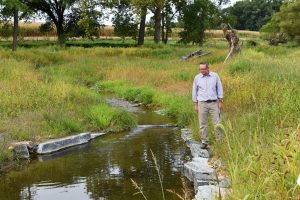Troy Anderson
TROY ANDERSON is EIP’s Director of Operations in the Eastern U.S., where he primarily focuses on projects east of the Mississippi River. Troy has over 27 years of experience in ecological restoration, monitoring, management, and construction—including prairies, wetlands, savannahs, streams, lakes, rivers, endangered species and unique habitats requiring critical regulatory performance standards. His extensive knowledge in the technical applications of restoration is paired with significant experience managing professionals and contractors. As of July 2025, Troy has been directly involved in the restoration of 8,817 acres of wetland and over 200 miles of stream in 7 USACE Districts across 7 States.
In addition to serving as former vice president of a mid-sized restoration firm, Troy has successfully permitted 404 projects in five different United States Army Corps of Engineers districts. Troy is also a frequent speaker at state and national conferences and a contributor to select publications.
Originally from southern Wisconsin, Troy currently lives in Baltimore County, Maryland, with his wife and two daughters. He is an avid outdoors enthusiast, and continues to become familiar with the Mid-Atlantic region. In the fall, there is nowhere Troy would rather be than following his German Shorthair in the field, looking for birds.

Q&A with Troy
Tell us about your role at EIP. What do you do?
My primary responsibilities fall neatly within my passion and skill set: evaluating lands to be restored and assembling teams to permit, build, and maintain degraded ecosystems. In addition to the project work, I also work closely with the Corps of Engineers and state agencies to ensure that performance standards are achieved so that we can deliver credits or water quality units.
What about this work drew your interest?
I grew up hunting and fishing with my father, exploring the lakes, fields and woods of Wisconsin. In college, I met a fellow student that was working part time with The Nature Conservancy who exposed me to some of the tools used in ecological restoration, including prescribed burning. At that point, the draw to the outdoors was even stronger and the drive to explore the variety of disciplines required to achieve ecological success set me on my journey that continues to this day.
What excites you about EIP’s impact in the world?
EIP has allowed me to implement landscape scale ecological restoration at a level I did not know existed. The ability to restore degraded land that was virtually void of life and transform it to a place of thriving interdependent community is one of the most gratifying accomplishments I have ever been a part of.
